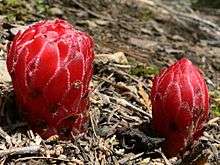Sarcodes
| Sarcodes | |
|---|---|
 | |
| Scientific classification | |
| Kingdom: | Plantae |
| (unranked): | Angiosperms |
| (unranked): | Eudicots |
| (unranked): | Asterids |
| Order: | Ericales |
| Family: | Ericaceae |
| Subfamily: | Monotropoideae |
| Genus: | Sarcodes |
| Species: | S. sanguinea |
| Binomial name | |
| Sarcodes sanguinea Torr. | |
Sarcodes is a monotypic genus of a single springtime flowering plant in the heath family (Ericaceae) containing the single species Sarcodes sanguinea, commonly called the snow plant or snow flower. It is a parasitic plant that derives sustenance and nutrients from mycorrhizal fungi that attach to roots of trees. Lacking chlorophyll, it is unable to photosynthesize.[1] Ectomycorrhizal (EM) symbioses involve a mutualism between a plant root and a fungus; the plant provides fixed carbon to the fungus and in return, the fungus provides mineral nutrients, water and protection from pathogens to the plant. The snow plant takes advantage of this mutualism by tapping into the network and stealing sugars from the photosynthetic partner by way of the fungus.[2] This form of parasitism is known as mycoheterotrophy.
The plant's aboveground tissue is its inflorescence, a raceme of bright scarlet red flowers wrapped in many straplike, pointed bracts with fringed edges, themselves bright red to orange in color.[3]

Sarcodes sanguinea is native to montane areas of the California Floristic Province, from the Oregon Cascade Range (as far north as the Umpqua River), through the mountains of California (though it is absent from the California Coast Ranges between the Klamath Mountains and the Transverse Ranges), and into the Sierra de San Pedro Mártir range of northern Baja California.
Its species epithet sanguinea refers to the striking red flower that emerges from the sometimes still snow-covered ground in early spring or summer; this may be as late as July in high elevations, such as those of the High Sierra Nevada and Cascades.[3]
See also
- Monotropa
 Media related to Sarcodes sanguinea at Wikimedia Commons
Media related to Sarcodes sanguinea at Wikimedia Commons
References
- ↑ Capon, Brian (2005). Botany for Gardeners (2nd ed.). Portland, OR: Timber Publishing. p. 127. ISBN 0-88192-655-8.
- ↑ Bruns TD; Bidartondo MI; Taylor DL (2002). "Host Specificity in Ectomycorrhizal Communities: What do the exceptions tell us?". Integr. Comp. Biol. 42 (2): 352–359. doi:10.1093/icb/42.2.352. http://icb.oxfordjournals.org/content/42/2/352.full.
- 1 2 Schoenherr, Allan A. (1995). A Natural History of California. Berkeley, CA: University of California Press. pp. 145–146. ISBN 0-520-06922-6.
External links
- Calflora:Sarcodes sanguinea
- Jepson Manual Treatment: Sarcodes sanguinea
- USDA Plants Profile for Sarcodes sanguinea
- Sarcodes sanguinea — U.C. Photo gallery